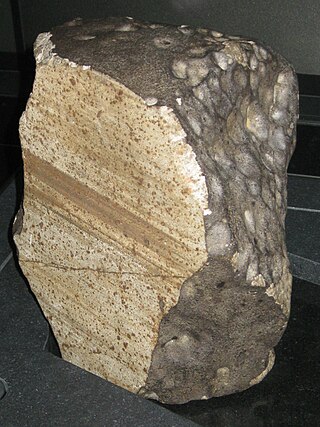
A meteorite is a solid piece of debris from an object, such as a comet, asteroid, or meteoroid, that originates in outer space and survives its passage through the atmosphere to reach the surface of a planet or moon. When the original object enters the atmosphere, various factors such as friction, pressure, and chemical interactions with the atmospheric gases cause it to heat up and radiate energy. It then becomes a meteor and forms a fireball, also known as a shooting star; astronomers call the brightest examples "bolides". Once it settles on the larger body's surface, the meteor becomes a meteorite. Meteorites vary greatly in size. For geologists, a bolide is a meteorite large enough to create an impact crater.

A meteoroid is a small rocky or metallic body in outer space.

An impact event is a collision between astronomical objects causing measurable effects. Impact events have physical consequences and have been found to regularly occur in planetary systems, though the most frequent involve asteroids, comets or meteoroids and have minimal effect. When large objects impact terrestrial planets such as the Earth, there can be significant physical and biospheric consequences, though atmospheres mitigate many surface impacts through atmospheric entry. Impact craters and structures are dominant landforms on many of the Solar System's solid objects and present the strongest empirical evidence for their frequency and scale.

The Wold Cottage meteorite fell near Wold Cottage farm in 1795, a few miles away from the village of Wold Newton in Yorkshire, England.

Jean-Baptiste Biot was a French physicist, astronomer, and mathematician who co-discovered the Biot–Savart law of magnetostatics with Félix Savart, established the reality of meteorites, made an early balloon flight, and studied the polarization of light.

Ernst Florens Friedrich Chladni was a German physicist and musician. His most important work, for which he is sometimes labeled as the father of acoustics, included research on vibrating plates and the calculation of the speed of sound for different gases. He also undertook pioneering work in the study of meteorites and is regarded by some as the father of meteoritics.
The year 1803 in science and technology involved some significant events.

L'Aigle is a commune in the Orne department in Normandy in northwestern France. Before 1961, the commune was known as Laigle. According to Orderic Vitalis, the nest of an eagle was discovered during the construction of the castle.

An iron meteorite fell on the Sikhote-Alin Mountains, in southeastern Russia, in 1947. Large iron meteorite falls have been witnessed and fragments recovered but never before, in recorded history, a fall of this magnitude. An estimated 23 tonnes of fragments survived the fiery passage through the atmosphere and reached the Earth.

Orgueil is a scientifically important carbonaceous chondrite meteorite that fell in southwestern France in 1864.

The Murchison meteorite is a meteorite that fell in Australia in 1969 near Murchison, Victoria. It belongs to the carbonaceous chondrite class, a group of meteorites rich in organic compounds. Due to its mass and the fact that it was an observed fall, the Murchison meteorite is one of the most studied of all meteorites.

A meteorite fall, also called an observed fall, is a meteorite collected after its fall from outer space was observed by people or automated devices. Any other meteorite is called a "find". There are more than 1,300 documented falls listed in widely used databases, most of which have specimens in modern collections. As of February 2023, the Meteoritical Bulletin Database had 1372 confirmed falls.

Park Forest is an L5 chondrite meteorite that fell on 26 March 2003 in Illinois, United States.

Albareto is a meteorite which in July 1766 fell near the frazione Albareto, of Modena, Emilia-Romagna, Italy.

The Weston meteorite is an H4 ordinary chondrite meteorite which fell to earth above the town of Weston, Connecticut on the morning of December 14, 1807.
Angers is an L6 meteorite that hit Pays de la Loire, France in 1822. The meteor struck at 8:15 PM on 3 June. It has since been stored along with L'Aigle, another meteorite that struck France 19 years earlier, on 26 April 1803, in a room at the Muséum d’histoire naturelle d’Angers, a French natural history museum.

Hraschina is the official name of an iron meteorite that fell in 1751 near the Hrašćina village in Hrvatsko Zagorje, Croatia. This meteorite is important because it was the first fall of an iron meteorite viewed and reported by a significant number of witnesses, despite its low remaining total known weight. The Hraschina meteorite also proved that rocks really can "fall from the skies".
This is a glossary of terms used in meteoritics, the science of meteorites.

Alais or Allais is the first carbonaceous chondrite meteorite identified. It fell near Alès in 1806 in multiple fragments which together weighed 6 kg, although only 0.26 kg (9.2 oz) remains. The meteorite contains a number of elements in similar proportions to the solar system in its primordial state. It also contains organic compounds and water. It has proved to be one of the most important meteorites discovered in France.

The Winchcombe meteorite is a carbonaceous chondrite meteorite that was observed entering the Earth's atmosphere as a fluorescent green fireball over Gloucestershire, England at 21:54 hours on 28 February 2021. Due to a public appeal, fragments were quickly recovered from the village of Winchcombe, enabling it to be collected for analysis before becoming degraded.


















